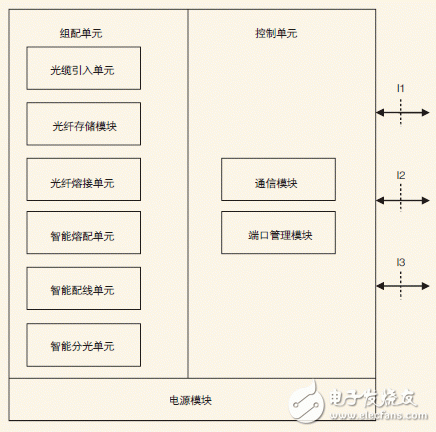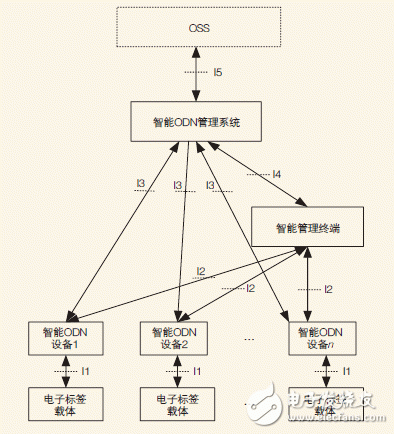introduction
With the gradual maturity of the intelligent ODN industry, the functions of automatic resource data reporting and fast route scheduling provided by the intelligent ODN industry have been widely recognized. What features and performance indicators should be truly intelligent and easy to use? Through a lot of practice, the author tries to make a simple analysis from the actual use experience, hoping to provide some help for the performance optimization of intelligent ODN.
Intelligent ODN architecture analysis
The basic components of the intelligent ODN system include the intelligent ODN device, the intelligent management terminal, and the intelligent ODN management system. The architecture reference model is shown in Figure 1.

Figure 1 Intelligent ODN system architecture
The electronic label carrier includes an optical fiber hopping fiber with an electronic tag, a pigtail fiber, and an optical splitter pigtail fiber. The main function of carrying the electronic tag is to connect with the intelligent ODN device through the I1 interface.
Intelligent ODN equipment includes intelligent ODF, intelligent optical cable transfer box, intelligent optical fiber cable splitting box and other equipment, mainly to collect, store and upload label information, write label information under controlled conditions, intelligent fiber deployment, resource data collection, Port positioning guidelines and other functions. The composition of the intelligent ODN equipment is shown in Figure 2. It consists of three parts: the assembly unit, the control unit and the power module. The assembly unit includes the optical cable introduction module, the optical fiber storage module, the optical fiber fusion module, the intelligent fusion module, and the intelligent wiring. The module and the intelligent optical splitting module can select one or more functional modules to form a grouping unit to complete the functions of optical fiber connection, distribution, and scheduling of the optical wiring device, and the intelligent functions unique to the intelligent ODN, according to different application scenarios.

Figure 2 Intelligent ODN device composition
As a portable device, the intelligent management terminal provides a management operation interface, mainly completes the access management function of the intelligent ODN device and the on-site construction management function, communicates with the intelligent ODN device through the I2 interface, and communicates with the intelligent ODN management system through the I4 interface. .
The intelligent ODN management system mainly implements the function of directly managing the intelligent ODN device or managing the intelligent ODN device through the intelligent management terminal, directly communicates with the intelligent ODN device through the I3 interface, communicates with the intelligent management terminal through the I4 interface, and passes through the northbound interface I5 and the OSS. Communicate.
Intelligent ODN function analysis
(1) Electronic tag reading and writing function
When a jumper or pigtail with an electronic tag is inserted into a port on the smart ODF panel, the port built-in reading device supports reading the electronic tag information of the inserted jumper or pigtail.
Under normal circumstances, electronic tags should be written in the factory to complete the pairing, but inevitably need to replace the tags when special circumstances occur in the field. In the controlled state, the intelligent OD F needs to support the on-site writing function of the electronic tag information.
More importantly, when the electronic tag of the intelligent ODF device fails, the electronic tag should be replaced without interrupting the service. If the electronic tag is added after the fiber is removed, the service will be interrupted for about 30 seconds on average. Therefore, the replacement of the uninterrupted service should be One of the important indicators of whether an intelligent ODN is available.
(2) Construction guidance function
It can indicate the port information to be operated, and at the same time support the intelligent management terminal to guide the construction and direct construction guidance of the intelligent ODN management system. At present, many intelligent ODNs only support the guidance of the intelligent management terminal for construction. However, in the scenario of stable power supply, the construction guidance using the intelligent ODN management system will eliminate the carrying problems of the on-site tools, especially when the cabinet construction is required. The guidance of the intelligent ODN management system will be more convenient.
When an error occurs, based on communication with the intelligent terminal or intelligent management system, the device can give an alarm message and simultaneously indicate the correct port information.
The resource comparison verification function should support intelligent ODN management system and intelligent management terminal verification.
(3) Resource management function
The port for intelligent ODF management refers to the fiber connector adapter port that is compatible with the fiber (jitter, pigtail). The intelligent ODF should support reading the inserted optical fiber electronic tag information, and the intelligent management terminal and the intelligent ODN management system generate an association relationship.
The intelligent ODF should support the automatic collection of resource information such as the device attributes, ports, and fibers corresponding to the port, and report the resource attributes of the device, port, and fiber associated with the port to the intelligent management terminal. Intelligent ODN management system.
(4) Alarm management function
Port alarm. When the power is turned on, the intelligent ODF monitors the port status. The status change can be reported to the intelligent ODN management system and the intelligent management terminal as an alarm or event. When the power is supplied by the intelligent management terminal, the alarm information should be reported to the intelligent management terminal.
Device alarm. When the status of the control unit and the service board/distribution card of the intelligent ODF is changed, the status change can be reported to the intelligent ODN management system and the intelligent management terminal as an alarm or event. When the intelligent management terminal is powered, the device alarms should be reported to the intelligent management terminal.
(5) Security management function
The operation of the intelligent ODF should be accessed through authorization and authentication of the intelligent ODN management system to prevent unauthorized devices from operating (reading, writing) devices and electronic tags.
Intelligent ODN performance analysis
(1) Equipment configuration
In the equipment configuration phase, the main impact on the use of the experience is the time of on-site software debugging. According to the site operation, the recommended configuration time is no more than 3s. The best solution is to use the pre-configuration scheme to avoid on-site configuration. It is understood that the current pre-configuration scheme is still not implemented.
(2) Construction
The main parameter in the construction phase is the response time of the device lighting after the port is plugged and unplugged. I have experienced more than 2s after a device jumper plugging, the 30s lamp can respond in bad conditions, the long-term waiting time has a great impact on the use experience, and the other device responds immediately after the user operates within 1s, almost no feeling. waiting time.
(3) Inspection
The main task of the inspection is to collect resources and proofread the incorrect ports. Some equipments are calculated according to the 576-core cabinet. The resource collection time is 600s, which should be increased to less than 10s. This makes the user feel more reasonable on site.
(4) Upgrade
The upgrade scenario is not a common scenario. When the near-end upgrade is adopted and embedded in the main process through automatic synchronization upgrade, it will have an impact on the construction operation of the site, and the use feeling at this time is poor. Therefore, it is recommended that the near-end upgrade be decoupled from the main process, accept only user approval, eliminate the impact on the main process, and enhance user experience. Remote upgrades can be used in scenarios where power can be stabilized, without the need for on-site personnel to participate.
(5) Power consumption
For smart ODN devices, the lower the power consumption, the less difficult it is to implement the power supply, and the more efficient the port scanning and signal transmission. In order to save energy and reduce the use of the product, low-energy products should be used.
At present, the main power consumption of the device is caused by the electronic tag, wherein the RFID electronic tag acquires energy through the antenna coil, and the energy conversion efficiency is very low ("20%"). When the RFID is applied in the intelligent ODN scenario, the power consumption of the single port reaches 18m W, and the time-sharing power supply is required to ensure the power consumption requirement, thereby directly affecting the device inspection time and the port information reading time. Due to the loss of energy conversion efficiency of eID, the power consumption of a single port is only 1.9mW, which can monitor each port in real time and can report alarms instantaneously.
(6) Resource information collection rate
According to the actual use, when the intelligent ODF configuration in the stable power supply scenario is not greater than 576 cores, the network management side resource collection time should be no more than 10s. Due to the limited power supply capability of the intelligent management terminal, the information collection time will be much longer than the network management directly collects information. Considering the actual situation, it is recommended that the information collection time of the intelligent management terminal should be no more than 30s, and the resource collection time under the stable power supply scenario should be no more than 20s.
(7) Alarm performance
When the intelligent ODF configuration is not greater than 576 cores in a stable power supply scenario, the alarm information reported to the NMS should be no longer than 3 seconds. During the on-site construction, the time when the alarm information is reported to the intelligent management terminal should be no more than 2s. When the intelligent management terminal guides the construction, the construction alarm starts from the insertion and removal of any optical fiber jumper, and the equipment on-site indication information (such as the LED indicator) changes, the time should be no more than 2s.
Decoration Ceiling Fan,Remote Control Ceiling Fan,Four Blades Ceiling Fan,Indoor Ceiling Fan With Light
Jiangmen MagicPower Electrical Appliances Co.,Ltd. , https://www.magicpowerfan.com